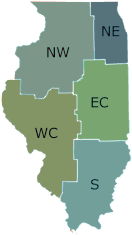The Cave is closed for the season and scheduled to re-open April 15, 2026.
The natural beauty that characterizes Illinois is more than skin deep, some of the state's most significant and scenic wonders lie far beneath the surface -- in Illinois caves. With more than 100 recorded caves, Monroe County has more caves than any other county in Illinois.
Illinois Caverns is the only cave that has been operated commercially in Illinois. In 1901 the cave, which was located on a farm of Frederick Eckert, was leased by a Mr. White of East St. Louis. A bound register kept at the caverns indicates that the first paying sightseers arrived April 23, 1901. Many early visitors were from the surrounding communities, but others came from distant states and even foreign nations.
Arriving at nearby Burksville Station by train, early visitors were met by horse-drawn wagons and transported the last few miles to the cave entrance. The cavern's passages and formations were illuminated by kerosene lamps attached to the walls. A steady stream of curiosity seekers marveled at the underground wonders during the run of the St. Louis World's Fair, but when the fair closed, visitation to the cave dropped. The first attempt to reap financial benefit from Illinois Caverns ended in 1907.
In 1947, the farm on which the cave was located was sold to William Hayden. Hayden and his nephew then made a second attempt to commercialize the cave. Some improvements were made, including the installation of electric lights in the main passageways. Advertisements proclaimed "Mammoth Cave of Illinois (as the cave was know in the early 1900s) -- One of the World's Most Beautiful Caves." The expected throngs of tourists did not materialize and the venture soon failed. Until Hayden's nephew, Robert, sold the cave to the State of Illinois in 1985, the site was only periodically visited.
About the time the Haydens' venture failed, Armin Krueger became the caretaker of the cave. Krueger was born about a quarter of a mile from the cave entrance and had spent much of his adult life guiding visitors through Illinois Caverns and exploring the caves of Monroe County.
Natural History
Illinois Caverns is located in southwestern Illinois in Monroe County about 35 miles south of St. Louis. This karst region known as the Sinkhole Plain contains one of the densest concentration of sinkholes in the US. The entrance to the cave (which also has been known as Burksville Cave, Manmmoth Cave of Illinois, Egyptian Cave and Eckert Cave) is located on a 118-acre tract which was purchased by the Department of Natural Resources in 1985.
The process of cave formation involves the power of water over rock. The rocks that form the base of the Illinois Ozark, Shawnee Hills and Mississippi Border natural divisions are the sort most susceptible to the forces of water. Millions of years ago huge, shallow seas covered much of this area and deposited many layers of organic and carbonate sediments, forming the limestone and dolomite bedrock that dominate the region today. These types of rocks are easily dissolved and carried off by water, especially along the subterranean cracks or "joints" common to these sedimentary deposits.
Over millenniums of time, the dissolving action of water along the subterranean cracks formed large, water-filled conduits or underground streams. Meanwhile, erosion on the surface began to cut valleys into the surrounding countryside. As the surface valleys deepened, some of the underground passages were drained, creating the air-filled passages known as caves.
During the cave-making process, water acts not only as a dissolver, but also as a builder. In the protected cave environment, dripping and seeping water can deposit carbonate materials and from a host of geological formations.
Natural Features
Illinois Caverns contains an extensive array of spectacular cave formations, including stalactites, stalagmites, rimstones dams, flowstone, and soda straws. Many of the formations are actively growing with the continued deposition of calcium carbonate. An underground stream meanders through the cave in its enriched bed. Throughout the year, the temperature in the cave remains a relatively constant 58 degrees Fahrenheit. Approximately 6 miles of the cavern's passages have been mapped by a caving group from Chicago, the windy City Grotto.
In addition to these cave formations, Illinois Caverns is home for a delicately balanced and fragile community of animals. The cave has an outstanding invertebrate fauna, including one of the largest numbers of troglobites (TB) and troglophiles (TP) (obligatory and facultative cave-adapted animals respectively) known from Illinois caves. The cave salamander and at least two species of bats–the little brown bat and tricolored bat–are commonly found in the cave.
West Central Illinois
4369 G Road
Waterloo
62298
38.234
-90.137




